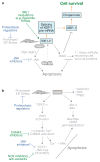Integrating the mechanisms of apoptosis induced by endoplasmic reticulum stress
- PMID: 21364565
- PMCID: PMC3107571
- DOI: 10.1038/ncb0311-184
Integrating the mechanisms of apoptosis induced by endoplasmic reticulum stress
Abstract
The ability to respond to perturbations in endoplasmic reticulum (ER) function is a fundamentally important property of all cells, but ER stress can also lead to apoptosis. In settings of chronic ER stress, the associated apoptosis may contribute to pathophysiological processes involved in a number of prevalent diseases, including neurodegenerative diseases, diabetes, atherosclerosis and renal disease. The molecular mechanisms linking ER stress to apoptosis are the topic of this review, with emphases on relevance to pathophysiology and integration and complementation among the various apoptotic pathways induced by ER stress.
© 2011 Macmillan Publishers Limited. All rights reserved
Conflict of interest statement
The authors declare no competing financial interests.
Figures




References
-
- Ron D, Walter P. Signal integration in the endoplasmic reticulum unfolded protein response. Nat Rev Mol Cell Biol. 2007;8:519–529. - PubMed
-
- Ron D, Hubbard SR. How IRE1 reacts to ER stress. Cell. 2008;132:24–26. - PubMed
-
- Hollien J, Weissman JS. Decay of endoplasmic reticulum-localized mRNAs during the unfolded protein response. Science. 2006;313:104–107. - PubMed
-
- Ma Y, Hendershot LM. Delineation of a negative feedback regulatory loop that controls protein translation during endoplasmic reticulum stress. J Biol Chem. 2003;278:34864–34873. - PubMed
-
- Seo HY, et al. Endoplasmic reticulum stress-induced activation of activating transcription factor 6 decreases cAMP-stimulated hepatic gluconeogenesis via inhibition of CREB. Endocrinology. 2010;151:561–568. - PubMed
Publication types
MeSH terms
Substances
Grants and funding
LinkOut - more resources
Full Text Sources
Other Literature Sources

